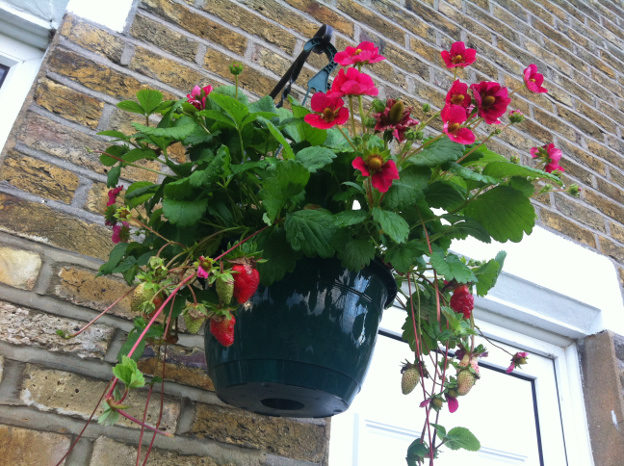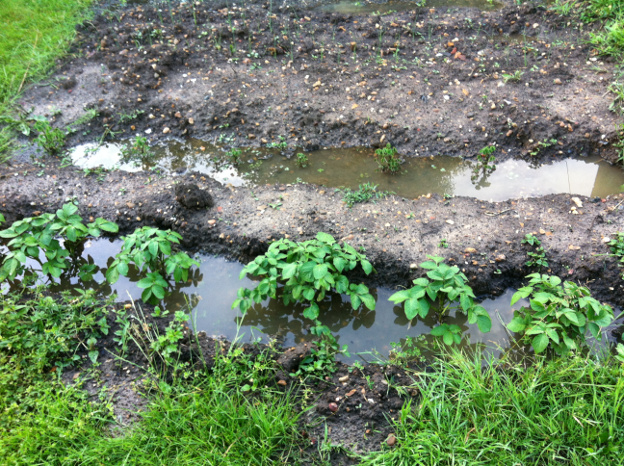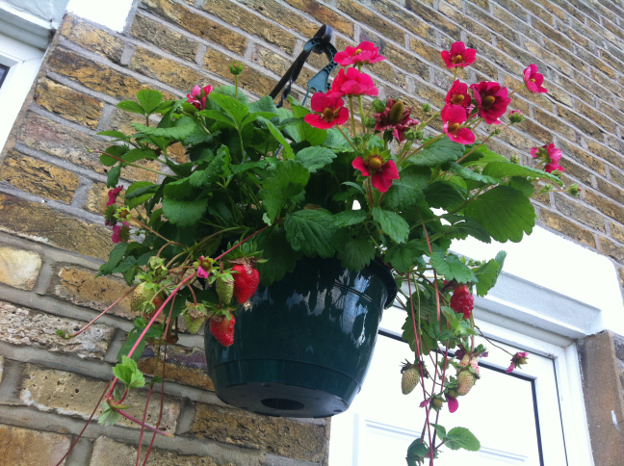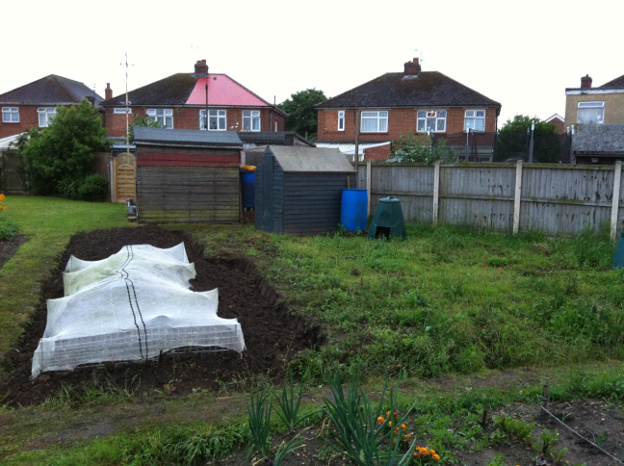Well, what a strange month June turned out to be! The most exciting news is that we now have an allotment! After that the biggest news has been the weather. The month started with a mini-heatwave which decimated crops in our plastic greenhouse, forcing us to get a move on and finish planting everything out. Then the wind and rain wreaked havoc with the plants once they were out!
It hasn’t felt like June. Early in the month (after the few hot days), it was quite cold. It may as well have been April. It’s warmed up somewhat now, but we’re still getting a lot of rain. The warm (but not hot) weather accompanied by the wet conditions has been great for the growth of our plants. But it has also been the perfect weather for the slugs and snails.
The Wind Damages Our Martock Field Beans
The week after the hot spell was very wet and windy and culminated in a storm and more downpours. The storm on the Friday night left several of our Martock field beans with bent stems. We were particularly disappointed about this, as there had been many occasions when we had gone out with the intention of staking them, only to get distracted by weeding or planting out. By the time of the storm we had only got round to staking one plant.
The next morning we were forced to stake about half of the others, as they could no longer support themselves. But I’m pleased to report that no real harm appears to have been done. Even the worst affected plants, those that now have distinct kinks in their stems, have since set beans.
Allotment Preparations
Now it was around this time that we received the offer of the allotment. It would be a few days before we had access to it, and it would take time to prepare the beds. The time of year also dictated what there was still time to sow. So we decided, not that we needed much convincing, to sort through our remaining squash seeds from last year and dedicate a whole bed of the allotment to curcubits.
The weekend of the Martock field bean staking I spent a good few hours digging some well rotted manure at some local stables. Accompanied by a neighbour and fellow vegetable grower, were we told we could take as much as we liked. This manure should prove very useful in light of our new squash growing capacity.
The Flooded Tubers
The following Thursday morning I was awoken by a downpour. Upon my return from work that evening it became apparent that it hadn’t stopped raining all day. Roads that aren’t usually vulnerable to flooding were flooded. I decided to inspect the garden and to my horror found the patch that was last year’s pumpkin patch, this year’s root vegetable and tuber patch, was partially flooded.
The biggest problem was the row of potatoes and the row of oca. We had planted these in trenches to aid the process of ‘earthing them up’. Although the trenches were mostly filled in, the rows were still sitting lower than the surrounding soil. The excessive rain had caused the looser soil around the plants to sink and flooded the trenches.
My biggest concern regarding the oca was the shoots that we had rooted in a glass because they snapped off of their tubers. Although these had been growing a little, without the energy stored in the tubers, there weren’t growing as fast as the rest of the row. They were the smallest of the oca tops, and the flood had submerged both. There was nothing for it, I was going to have to attempt to drain the trenches.
I dug a pit immediately at the end of the row of oca, and I was pleased to see the water level start to drop as it drained into the hole. It was soon full and so I had to dig deeper and longer. Eventually I was relieved to see the majority of the water drain off, and the shoots of even the smallest two oca tops visible again.
I attempted the same with the potatoes, but after draining the water off there were still individual puddles around each top. I was scared of digging too close to the plants in case I damaged the roots. Sweating and with the rain starting again I decided to call it a night. The forecast for the next day was dry with some sun, hopefully summer would finally begin and this would be one of those incidents where I would look back and laugh at how worried I was about nothing.
The next morning started dry and bright and as I left for work I went via this area of the garden. I was pleased to see that it was looking a lot better, although there was still some water collected around the potatoes. The grass in the surrounding areas was completely saturated still. That day was a sunny and dry one, and I’m pleased to say that evening everything was looking a lot better, apart from the enormous holes I had dug, one of which was still quite full of water.
The bed is no longer flooded, but a week later and I’ve still not had to water it at all. It’s not really had a chance to completely dry out as it’s rained almost every day since. I can’t help but think that what with the digging and sieving of the very stony soil before we planted the potatoes and oca, and then the further digging to drain them when they flooded, that no matter how many of them I eat, I’ll still be in a calorie deficit overall!
A Different Tuber Crop
We’ve not mentioned this crop before, but we are in fact growing a third type of tuber this year: Jerusalem artichokes. We have set a small area of the large vegetable patch in the garden aside to grow these. At the end of last year, New Year’s Eve in fact, my dad brought some Jerusalem artichoke tubers round from his allotment, and we planted them in the far corner next to what is now the fruit patch.
There was no sign of any growth even as late as early April, and then suddenly there they were. Not just small shoots, but enormous stems! They must be nearly 6 feet tall now. They grow very quickly once they get going. We’ve never grown these in our own garden before, but we have harvested them several times from our local community garden, and we quite like them.
They say once you grow Jerusalem artichokes you’ll never get rid of them. This appeals to us greatly. The tubers form in clusters and when the plants are lifted, small tubers are commonly left behind, which will grow into enormous plants the next spring, and so the cycle continues. Not great if you are trying to clear them from an area that you wish to use for something else, but a very low maintenance crop if you’re happy to set an area aside for them.
Fruits Forming
I do love this time of year when the fruits really start to become recognisable on the trees. We can already see our plum trees laden with rapidly growing green fruits. Clusters of golf ball sized apples have formed on the apple trees. No June drop yet, but given the weather we’ve been having, the trees probably think it’s about April. But my favourite is the dwarf medlar tree that we have on the patio. I just think it looks gorgeous when the fruits start forming at the pinnacles of the branches full of those elongated leaves.
Strawberries Galore
It’s been a great year for strawberries. Our Cambridge Favourites have been delicious this year. We’ve had a few Albion strawberries, mostly eaten by the kids, who appeared to enjoy them. Liz and I shared one, and frankly I’ve had sweeter lemons. I wonder whether it’s because it grew in the back yard and not in full sun.
We’ve also tried a rather interesting new variety of strawberry this year. I saw it for sale in a hanging basket outside of a supermarket. The variety is called ‘Fragoo Deep Rose’, and the flower petals are a dark pink, almost purple colour. There were also ‘Fragoo Pink’ and a ‘Fragoo White’ varieties for sale, with the names denoting the colours of the flowers.
I thought the Deep Rose the prettiest and so I bought one of those. I largely bought this variety for its flowers. We were doubly happy when we found that the fruits are absolutely delicious – very sweet and a real burst of that classic strawberry flavour. The plants are prolifically producing runners, so we’ll be sure to propagate some more of these and grow a larger crop next year.
Further Progress At The Allotment
We’ve made a little more progress at the allotment. I posted a few days ago that we’d planted some brassicas out. The next evening I went back to cover them with some recycled scaffolding netting, which was saved from landfill by my friend Joe. The purpose of this was to act as a barrier to prevent cabbage white butterflies from laying their eggs on our young plants. These eggs would hatch into caterpillars, which would devastate our young plants.
I haven’t heard of any sightings of the butterflies yet, nor have I seen any evidence of them this year. Perhaps it’s too windy for them at the moment. But I didn’t want to be complacent. So I made it a priority to get them covered. That task done I carried on turning the soil to prepare the beds. As you can see from the photo below, it’s really starting to take shape now.
That’s about all there is to report on since our early June growing update. Aside from what I’ve already reported, we’ve also been busy planting out our tomatoes, runner beans, pea beans, courgettes etc in the garden. But more on that next month when I’ll hopefully also have some impressive photos to post of our plants thriving in some glorious July weather. Here’s hoping!






